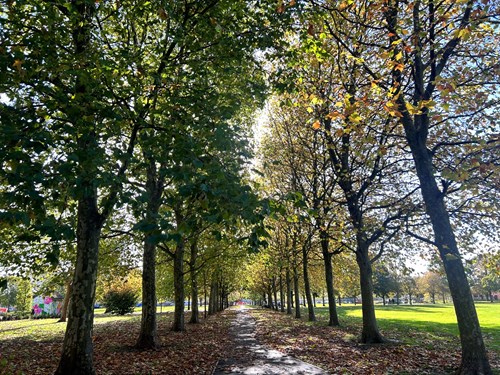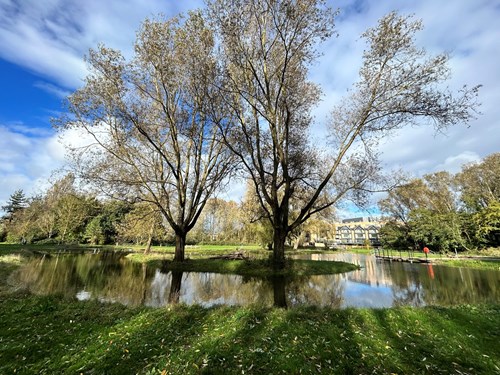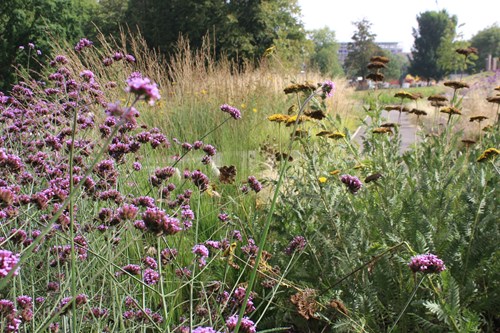Victoria Park Ecology
Victoria Park is a great space for both people and wildlife. The trees, river, pond and long grass areas provide habitats for many species of birds, butterflies and other insects.
Trees of the Park
There are lots of trees throughout Victoria Park and Watercress Fields, both native and more exotic species. Watercress Fields has mostly native species, including ash, oak, birch, hawthorn, and field maple. Most of these trees were planted to form hedges or small woods.
In Victoria Park the trees are more exotic and have been planted with space to grow to show their full form, or to line paths and avenues. Species include the tulip tree, liquid amber, horse chestnut and a line of commemorative oaks on the northern edge; the oldest trees in the park at around 150 years old.

Watercress Community Orchard
Watercress Community Orchard was planted by the community* in 2012, and in 2020 when more trees were added as part of the Victoria Park Project.
The apple trees of this traditional orchard will grow quite large and provide food and homes for many creatures. Around the apple trees are quince, medlar, pear, plum and cherry trees. Almost all are Kentish varieties.
*Kentish Stour Countryside Partnership volunteers, Ashford Oaks Primary School pupils, Hang 10 Youth Group and Friends of Victoria Park
The Great Stour River
The Great Stour is a rare chalk river which runs along the edge of the park. In total the river is approximately 51 miles long and runs through the Weald, from Lenham via Ashford to Canterbury and Sandwich. There are only 210 chalk rivers in the world and 85% of those are in England. Chalk rivers form from water that flows through chalk hills. The water is clear and rich in minerals, creating a wonderful habitat for species including water voles, kingfishers and white-clawed crayfish (small lobster-like crustaceans, measuring 6-12cm). Otters and beavers have been spotted in Ashford too!
The river within the park has a natural profile with many meanders and wide margins of vegetation that support a diverse range of riverside plant species, including cuckoo flower and alder. The river corridor designation is Local Nature Reserve and forms part of the Ashford Green Corridor, linking south Ashford with the countryside and town centre.
Too much litter, especially plastic, is getting into our rivers. Bad for river wildlife such as trout, kingfishers and eels, it also floats out to sea where it continues to do harm. Plastic breaks down in tiny micro-plastics where it is swallowed by many sea animals; not only making them ill, but potentially those that eat them – like us.

Chalk river with river water-crowfoot. Image courtesy of Kentish Stour Countryside Partnership
Victoria Park’s seasonal wetland
Victoria Park’s wetland was created in 2023 and was designed to be seasonal, filling and draining according to the weather conditions and level of the river.
A shifting wetland like this is an important habitat for wildlife like frogs, newts and toads whose young would otherwise be eaten by fish or waterfowl living in permanent wetlands. Lots of aquatic insects depend on this type of habitat too, as all or part of their life cycle tales place in its water. For many animals, the water and vegetation provide protection from disturbance and predators. Some of our rarest animals live around wetlands, including the water vole, bittern and hen harrier.
Wetlands are great places for spotting wildlife. Even if animals don’t live here, many will visit to drink or catch their prey. Today wetlands only make up 3% of the UK yet are home to 10% of all our wildlife species, making them very important habitats. Like trees, they are also wonderful at storing carbon.

The Importance of Biodiversity
Biodiversity is the variety of natural species, plant and animal, found in an area. We know that the greater biodiversity the healthier a place is for all living things. Bioabundance (the size of the population of these species) is also important as this has a massive impact on whether the biodiversity of a space is sustainable.
Environments large and small, from hedge to forest, are habitats. Each different habitat is a potential home for wildlife. The more habitats in an area, the greater its biodiversity. There are several habitat types in the park; pond, river, meadow, woods/trees and a wetland. You may be surprised by the range of wildlife you could see in the park, if you are patient and know when and where to look.
For example, pipistrelle bats live in cracks and holes in large trees. The bats prefer to be close to open areas where they can hunt and feed on their prey - flying insects. So, keep a look out at dusk for bats!

Want to know more?
If you are interested in reading more about the ecology of Victoria Park and Watercress Fields, please download the Victoria Park Ecological Report [pdf] 2586KB.






